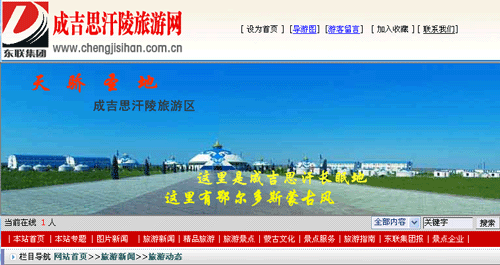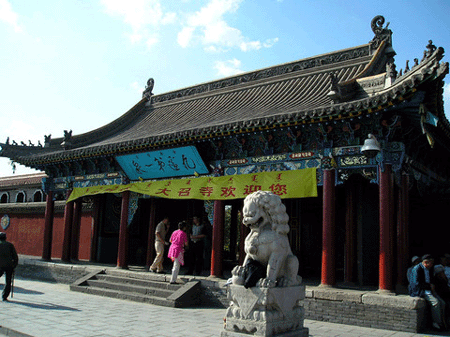|
Cultural
and Religious State of the Mongols in China
New York,
July 27-28, 2006
Ladies and
gentlemen,
My name is
Enhebatu Togochog. I represent the Southern Mongolian Human
Rights Information Center. I am honored to be here today to
share with you information regarding the human rights situation
of Mongols in China, My remarks will concentrate on the on-going
threats to the cultural and religious identity of Mongols
residing in the Southern Mongolia Autonomous Region of China.
The legal basis for religious and cultural freedom for
minorities might be said to have been established with the
promulgation in 1982 of the “Constitution of the People’s
Republic of China.” Article 4 specifically guarantees protection
and preservation of minority cultures in China. It states in
part:
All
nationalities in the People's Republic of China are equal.
The state protects the lawful rights and interests of the
minority nationalities and upholds and develops the relationship
of equality, unity and mutual assistance among all of China's
nationalities. ….Regional autonomy is practiced in areas where
people of minority nationalities live in compact communities; in
these areas organs of self- government are established for the
exercise of the right of autonomy. …. The people of all
nationalities have the freedom to use and develop their own
spoken and written languages, and to preserve or reform their
own ways and customs.
In addition, Article 36 of the constitution protects religious
believers:
“… No state organ, public organization or individual may
compel citizens to believe in, or not to believe in, any
religion; nor may they discriminate against citizens who believe
in, or do not believe in, any religion…”
The “Regional Ethnic Autonomy Law of the People’s Republic of
China,” issued by the Second Session of the Sixth National
People’s Congress in 1984 and amended in 2001, extends both
protection and preservation. It states that minority
nationalities living in compact communities are entitled to
enjoy cultural and religious freedom without any interference by
state organs or individuals. According to the Article 10,
“autonomous agencies in ethnic autonomous areas guarantee the
freedom of the nationalities in these areas to use and develop
the own spoken and written languages and their freedom to
preserve or reform their own folkways and customs.” Article 11
guarantees “freedom of religious belief to citizens of the
various nationalities.”
China’s February 2005 white paper on ethnic minority issues,
entitled “Regional Autonomy for Ethnic Minorities in China,”
reiterated the rights of minorities including their right to
define their cultural and religious beliefs and practices.
Against this backdrop, I turn now to the reality of cultural and
religious rights in Southern (Inner) Mongolia today.
 |
|
| Chinggis Khaan
Mausoleum, a sacred worship place of the Mongols, is
commercialized by a Chinese company named Dong Lian Group. |
|
During the past 60 years, under the slogan of “development of
the borderlands”, a massive population transfer has taken
place in Southern Mongolia where the indigenous Mongols
themselves have become an absolute minority. According to
China’s National Census 2005, the Mongolian population comprises
only 17.65% of the total population in Southern Mongolia. It is
highly likely that the population transfer policy in Southern
Mongolia served as a model for Han population transfer into East
Turkystan and Tibet.
Equally
important, the ecology of Southern Mongolia was seriously
damaged by migrant farming of the region’s grasslands. Today’s
frequent sandstorms and droughts are just one consequence of
what turned out to be a non-sustainable way of earning a living.
Ironically, the Chinese government blames the ecological
devastation caused by the millions of migrant farmers on the
livestock practices of the nomadic Mongols. Under a policy of
“ecological migration,” the government since 2001 has been
forcing Mongol herders to give up their traditional nomadic way
of life to adopt urban and agricultural life-styles.
Mongolian language education has steadily declined and in recent
years, an increasing number of Mongolian language schools have
been forced to either close or have been absorbed into the
Chinese language school system.
According to complaints from rural
Mongolian communities, today almost all Mongolian elementary
schools at the level of Gachaa (the second smallest
administrative unit) are being eliminated, and most Mongolian
middle schools at the Sum level (the third smallest
administrative unit) are being merged into Chinese teaching
schools. Mongolian students are therefore left with no choice
but to learn Chinese.
Despite
the fact that Mongolian language is the official language in
Southern Mongolia, the Region’s postal authorities have been
known to refuse delivery of mail and packages addressed in
Mongolian script.
According
to a communication from Southern Mongolia, a Mongolian language
Internet chat-room called “Mongolian Net Communications” was
shut down in April this year after being accused of “advocating
for Southern Mongolian independence” because the chats were in
Mongolian rather than Chinese. Many other Internet sites such as
nutuge.com, ehoron.com and munhgal.com that promoted Mongolian
language usage and preservation of Mongolian culture have been
shutdown for “publishing separatist contents.”
Other
examples of threats to cultural survival included a 2004 plan by
the local government in Ordos, Southern Mongolia, to sell the
mausoleum of Chinggis Khan to a private company. His shrine,
revered by Mongols everywhere, was to be turned into a
commercial theme park. In another case, a well-known Mongolian
physician named Naguunbilig and his wife Daguulaa were arrested
for practicing traditional Mongolian medicine. Their trial was
started and is currently in recess.
 |
|
| nutuge.com, an
Internet discussion forum of Mongolian intellectuals, was
shut down in 2004 by the Chinese authorities for "violating
state laws". |
|
Some
Mongols who seek to find some means to preserve Mongol culture
are persecuted. Hada, a well-known intellectual, now in the 11th
year of a 15-year sentence for establishing the “Southern
Mongolian Democratic Alliance,” is one such individual. Human
Rights in China and Amnesty International have reported that
over the years he has been routinely tortured.
Regarding
the state of religion in Southern Mongolia, I will focus mainly
on Buddhism which is the traditional religion of the Mongolian
people. Buddhism has been the predominant religion of Mongols
and an integral part of Mongol cultural identity since the late
16th century. Buddhist temples served as centers of
Mongolian intellectual life. Until the takeover of Southern
Mongolia by the Chinese Communist Party in 1947, Buddhist
traditions and practices remained largely intact.
During the
Cultural Revolution, almost all Buddhist temples in Mongol areas
were destroyed, and lamas were dispersed, otherwise removed, or
forced to give up their vows of monkhood. At present, only a
handful of temples are operative; and lamas in Southern Mongolia
are few and far between. The exact statistics are not known. One
estimate suggests that some 40 percent of the Mongol population
acknowledge their Buddhist beliefs. Under the pretext of
“disturbing public order,” “organizing an illegal gathering,” or
“advocating superstitious beliefs,” individuals may be
persecuted for religious practice.
Two
bureaucracies, the government’s Religious Affairs Bureau (zong
jiao ju) and the Chinese Communist Party’s United Front (tong
zhan bu), both with branches at all administrative levels,
tightly control all religious activities through the formulation
of laws and regulations and through day to day management of
Buddhist institutions.
Recruitment of prospective monks previously took place when boys
were 8-10 years old. Today, recruiting young people under the
age of 18 is strictly prohibited. The regulation has interfered
with the traditional teacher-student relationship and with the
transmission of teachings and doctrine.
Publication of Buddhism materials is strictly controlled. During
the Cultural Revolution (1966-76), it was a crime to publish
Buddhist publications. In the1980s, Buddhist publications were
permitted if the authorities were satisfied that a clear
connection to a non-religious purpose, such as the promotion of
culture or the study of history, existed. Since the 1990s,
Buddhist publications are less regulated, but circulation is
strictly controlled. Publications are offered only to temples
and monks. Authorities consider all religious activities
practiced outside a “designated place” as “illegal and
superstitious [activities designed to] dupe the common public.”
Government officials regularly go to temples to force lamas to
participate in so-called “political study” indoctrination.
 |
|
| Ikh-zuu Temple of Huhhot
City: more tourism, less Buddhism. |
|
Because
government authorities view large organized religious gatherings
as having the potential to undermine the Party control,
Mongolian Buddhist institutions are prohibited from
communication with their Tibetan counterparts and laws and
regulations forbid “inter-regional religious activities” (kua
di qu xing zong jiao huo dong”).
Temples
are expected to sustain themselves financially. But private fund
raising is generally prohibited. If funds are collected, it is
expected that they will be shared with the religious
bureaucracy. Religious authorities, recognizing the potential
revenues to be realized, have converted many temples into
tourist attractions rather than sites for religious study and
worship. Lamas are particularly disturbed by tourists and
government officials who disrupt religious worship at will.
In
addition, all temples must regularly report their activities to
the relevant religious authorities. All lamas must sign a
contract and pledge loyalty to the Party and government.
It is
clear that authorities in Southern Mongolia discourage Buddhist
belief and practice, that access to places of worship is limited
and that individuals risk persecution for religious practice.
Party members must be atheists.
Government
and Party interference through bureaucratic means has
irreversibly altered institutional and traditional practices and
significantly altered traditional power centers within the
religious hierarchy. The sum of the changes suggests that
survival and relevance of Buddhism Southern Mongolia cannot be
taken for granted.
In sum, the systematic erosion of cultural and religious rights
for Mongols in China, suggests that that the laws and
regulations promising autonomy have not been translated into
meaningful state policy. Regional autonomy has not
guaranteed the rights of Mongols to freely use their own
language, to preserve and promote their traditional culture, to
practice their religion without interference, in short, to
preserve their cultural identity.
The future looks bleak. |





